Jörg Wunderlich
Personal Website
Welcome to the personal website of Jörg Wunderlich (*1939), arachnologist, biologist and palaeontologist in Germany.
Fascinated by their aesthetics, diversity, behaviour, and evolution I described about one and a half thousand of species of spiders for the first time mainly from the Canary Islands and from fossils in amber.
I am highly interested in evolution and evolvolution (the possibilities and the limits of evolution) of biotic and abiotic systems as well as in economy and free thinking.
As editor and owner of the Publishing House Joerg Wunderlich I published several volumes of the "Beiträge zur Araneologie (Beitr. Araneol.)" on extant and fossil spiders, (see Books & Other Publications).
Jörg Wunderlich: Vita

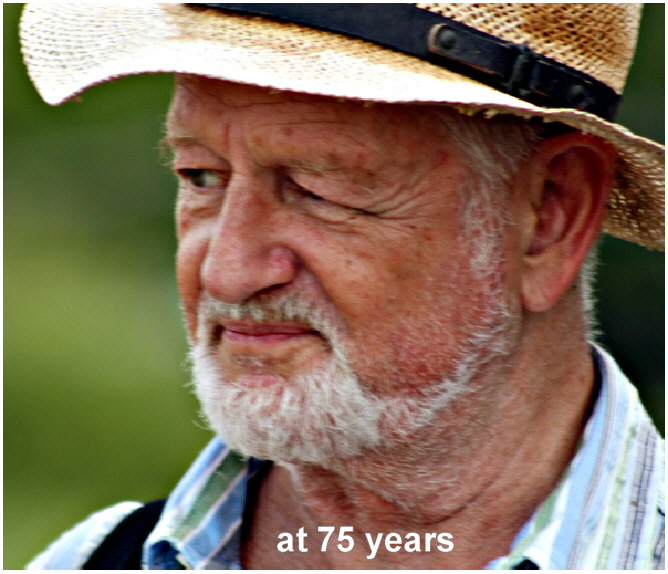
Private Laboratory of Arachnology.
Editor of the Beiträge zur Araneologie (Beitr. Araneol.) (in English), author
of ten books (see Books
& Other Publications), and more than 100 papers on extant
and fossil spiders (taxonomy, evolution, biogeography and behavior).
Member (e.g.) of the Arachnologische Gesellschaft, European Society of Arachnology, International Society of Arachnology, Palaeontologische Gesellschaft.
Former student of (e.g.) Zoology, Botany, Geography, Philosophy and Political Science at the Free University in Berlin, taught biology for 25 years at a secondary modern school in Germany, and has published on extant and fossil spiders for about fifty years.
News
The fossil spider of the year 2015
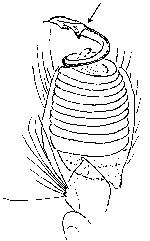 (selected by the editor and friends)
(selected by the editor and friends)
This peculiar male fossil spider, dorsal aspect, body length only 2.8 mm, lived 100 million years ago in a rain forest of Myanmar (Burma). It is first described as Burmadictyna excavata of the extinct Cretaceous family Salticoididae, a group of orb-web weaving spiders.
What is unique in this spider species? From certain structures of the male copulatory organ we can conclude a special mating behaviour of this species which is known to be similar in some spiders of today. This behaviour concerns the most important part of the male copularory organ, the EMBOLUS of the pedipalpus (see the drawing above) which has the main function of a penis: it transfers the sperm to the female copulatory organ.
The embolus of this fossil male has quite an unusual structure:
(a) It is coiled in 12 loops of spirals which build a long cylinder. I estimate that this genital part represents 3.5 (!) times the length of the spider’s body. No one knows the reason for the evolution of such a long introductory structure of the male genital organ, and how it was used by the spider!
(b) The apical part of the embolus (arrow in the drawing) is strongly modified and widened, bearing barbs in a harpoon-shaped structure. It has a basal constriction, which I regard to be connected with a breaking line in this area. – What about the function of this structure? Male spiders of several families of today – frequent are orb weavers – are known to possess a very special behaviour in connection with a peculiar part of their embolus: A part of this copulatory organ breaks off and is left within the genital duct of the female after copulation. Such a „mating plug“ is considered to prevent the intromission of sperm by other males, to secure the development of offsprings only of its own. Furthermore it is a peculiar case of GENITAL SELF-MUTILATION, and the same pedipalpus is probably not usable for a further copulation. Such structures exist at the end of both emboli in all the three known fossil males of this genus; so we may conlude that none of them did have sex. The present male (photo) is the first proof of such a behaviour in fossil spiders. It demonstrates that the use of mating plugs is a very old behaviour in spiders, dating back at least 100 million years.
See: Beiträge zur Araneologie (Beitr. Araneol.), vol. 9, p. 3; MESOZOIC SPIDERS and other fossil Arachnids (the spider is described p. 314-317, photos 156-159.)
Books by the Publishing House Joerg Wunderlich - Beiträge zur Araneologie
Beiträge zur Araneologie (Beitr. Araneol.), vol. 1:
The Spider Fauna of the Macaronesian Islands
WUNDERLICH, J. (1992) (for 1991)
The Spider Fauna of the Macaronesian Islands. Die Spinnen-Fauna der Makaronesischen Inseln. Taxonomy, ecology, biogeography and evolution.
619 pp, 860 figs. (Remark: This is the second volume to - The Spiders of the Canary Islands and Madeira -, see below).
Download
Beitr._Araneol._Band_1_(1991).pdf
(57 MB)
Beiträge zur Araneologie (Beitr. Araneol.), vol. 2:
The fossil Spiders in Dominican amber
WUNDERLICH, J. (1988)
The fossil Spiders in Dominican amber.
Die fossilen Spinnen im Dominikanischen Bernstein.
378 pp, 788 figs. and 89 photos.
Download
Beitr._Araneol._Band_2_(1988).pdf (25
MB)
Beiträge zur Araneologie (Beitr. Araneol.), vol. 3:
Fossil Spiders in Amber and Copal
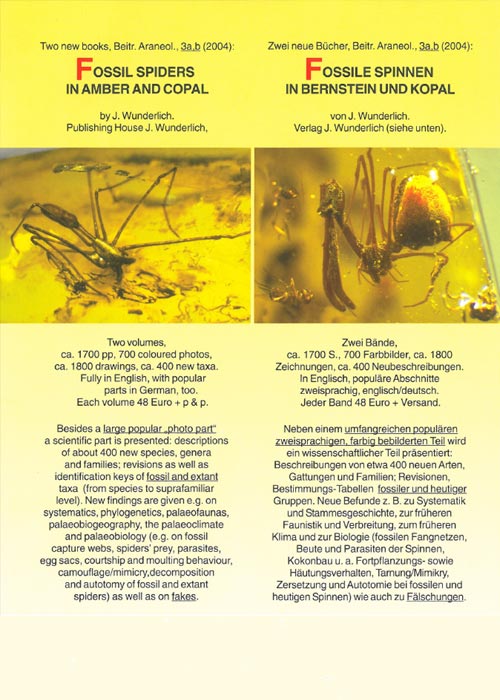
WUNDERLICH, J. (2004)
Conclusions, revisions, new taxa, family diagnoses of fossil and extant taxa. Volumes A and B;
Besides a large popular "photo part" a scientific part is presented: Descriptions of about 400 new spider species, genera and families mainly in Baltic amber; revisions as well as identification keys; new findings e. g. on systematics, phylogenetics, palaeofaunas, palaeobiogeography, the palaeoclimate and palaeobiology (e. g. on fossil capture webs, spiders' prey, parasites, egg sacs, courtship and and moulting behaviour, camouflage/mimicry, autotomy) as well on fakes.
1908 pp, 696 coloured photos, ca. 1800 drawings.
Download
Beitr._Araneol._Band_3_A_(2004)_1-330.pdf
(34 MB)
Beitr._Araneol._Band_3_A_(2004)_331-594.pdf
(20 MB)
Beitr._Araneol._Band_3_A_(2004)_595-850.pdf
(12 MB)
Beitr._Araneol._Band_3_B_(2004)_851-1450.pdf
(41 MB)
Beitr._Araneol._Band_3_B_(2004)_1451-1908.pdf (18
MB)
Beiträge zur Araneologie (Beitr. Araneol.), vol. 4:
A collection of 62 papers
WUNDERLICH, J. (ed.) (1995) (for 1994)
Papers by different authors on taxonomy, phylogeny, ecology, biogeography and faunistics of extant (mainly) and fossil spiders (Araneae).
778 pp.
Beiträge zur Araneologie (Beitr. Araneol.), vol. 5:
Fossil and extant Spiders (Araneae)
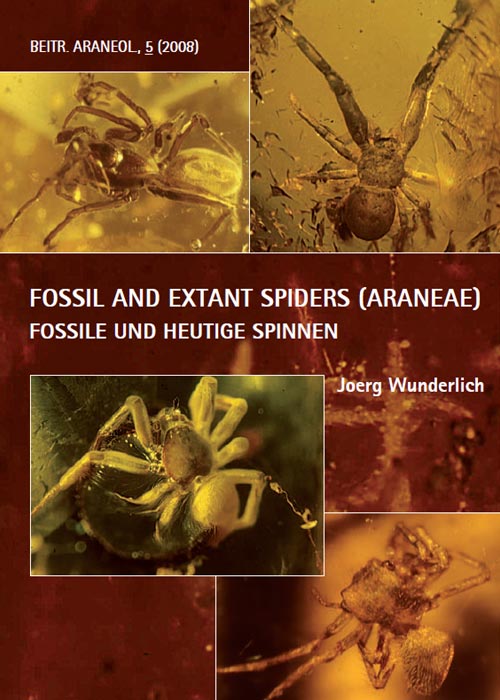
WUNDERLICH, J. (2008)
Phylogeny, diversifications, extinctions, biogeography, ecology and ethology; with descriptions of new fossil and extant taxa.
870 pp, about 400 coloured photos and 1000 drawings.
Download
Beitr._Araneol._Band_5_(2008).pdf
(17 MB)
Beitr._Araneol._Band_5_(2008)_Farbteil.pdf
(19 MB)
Beiträge zur Araneologie (Beitr. Araneol.), vol. 6:
Extant and fossil Spiders (Araneae)
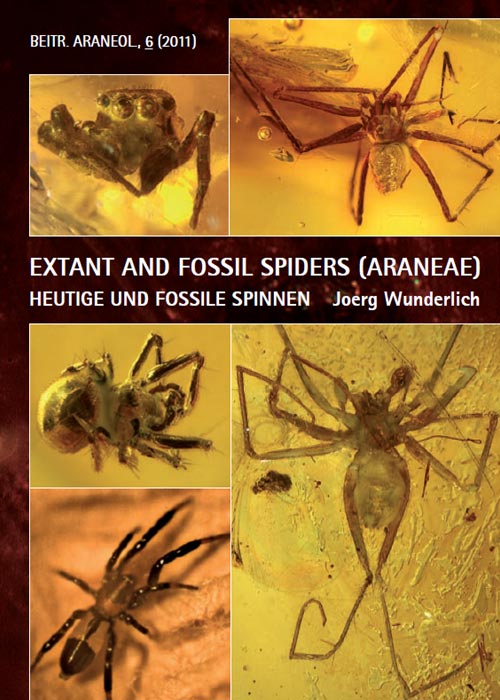
WUNDERLICH, J. (2011)
Extant and fossil Spiders (Araneae).
640 pp, more than 100 coloured photos. Additions to the volumes 3 and 5.
Download
Beitr._Araneol._Band_6_(2011).pdf
(13 MB)
Beitr._Araneol._Band_6_(2011)_Farbteil.pdf
(10 MB)
Beiträge zur Araneologie (Beitr. Araneol.), vol. 7:
Fifteen Papers on Extant and Fossil Spiders
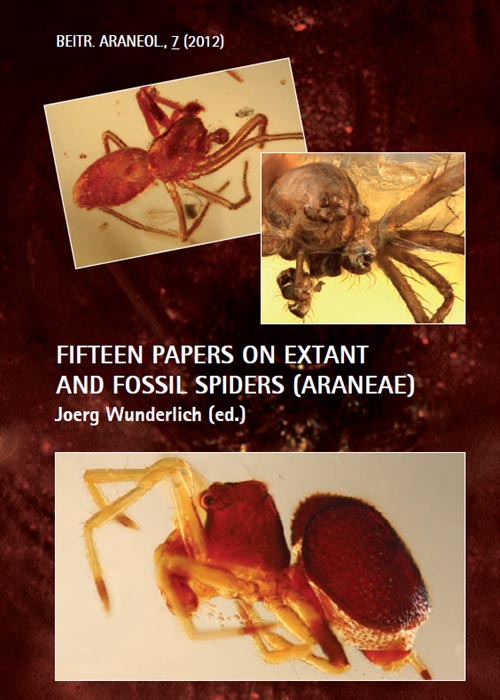
Joerg Wunderlich (ed.); 2012
Fifteen Papers on Extant and Fossil Spiders.
364 pp, about 145 coloured photos.
Download
Beitr._Araneol._Band_7_(2012).pdf
(15 MB)
Beiträge zur Araneologie (Beitr. Araneol.), vol. 8:
The Spider Families of Europe
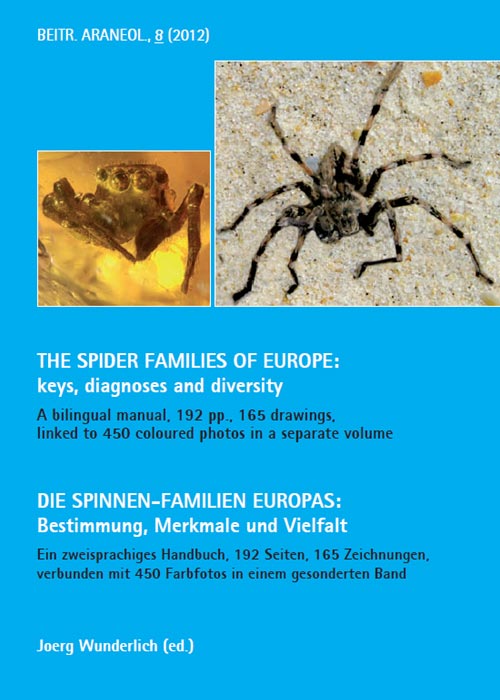
WUNDERLICH, J. (2012)
The Spider Families of Europe: keys, diagnoses and diversity. A bilingual manual.
192 pp., 165 drawings; linked to 450 coloured photos in a separate volume.
Die Spinnen-Familien Europas: Bestimmung, Merkmale und Vielfalt. Ein zweisprachiges Handbuch.
192 Seiten, 165 Zeichnungen; verbunden mit 450 Farbfotos in einem gesonderten Band.
Download
Beitr._Araneol._Band_8_(2012).pdf
(6 MB)
Beiträge zur Araneologie (Beitr. Araneol.), vol. 9:
MESOZOIC SPIDERS and other fossil Arachnids
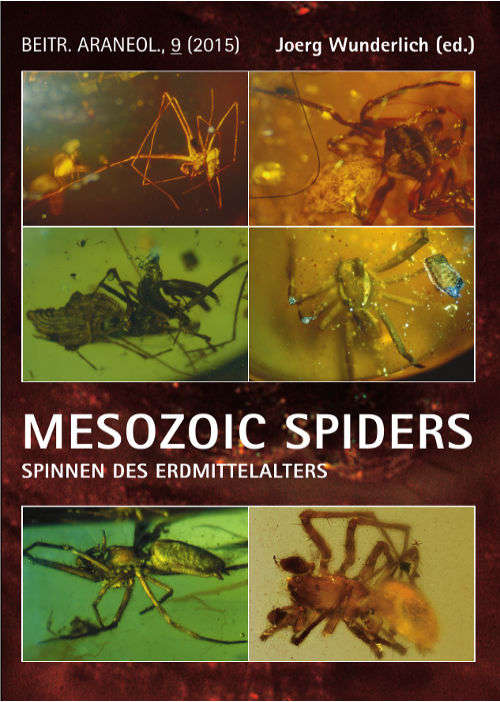
WUNDERLICH, J. (ed.) (2015)
This book contains numerous new descriptions of taxa mainly in Cretaceous
Burmese amber, including a new extinct family of spiders, a new extinct suborder
of the arachnid order Ricinulei, the fossil spider of the year 2015, a proposed
new classification of spiders, spider evolution, the biogeography and the behaviour
of spiders, fossil spider faunas, extinction events etc.
Beitr. Araneol., 9 (2015)
512 pp, ca. 450 drawings and 212 coloured photos.
Download
Beitr._Araneol._Band_9_(2015).pdf
(15 MB)
Beiträge zur Araneologie (Beitr. Araneol.), vol. 10:
Ten Papers on fossil and extant Spiders (Araneae)
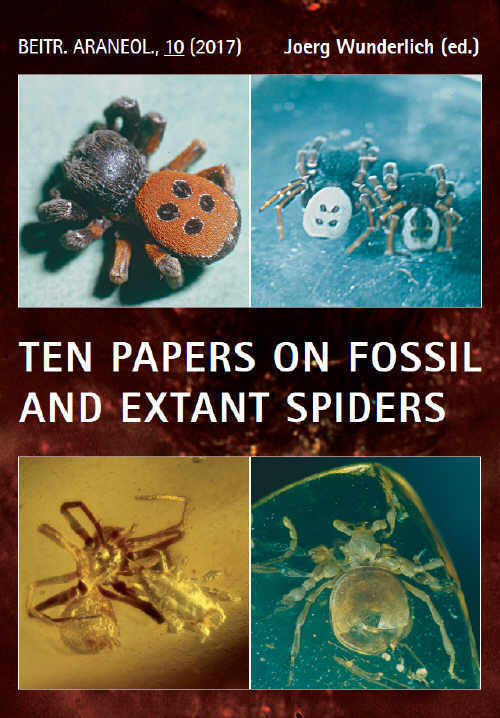
WUNDERLICH, J. (ed.) (2017)
Beitr. Araneol., 10 (2017)
358 pp, ca. 300 drawings and 135 coloured photos.
Download
Beitr._Araneol._Band_10_(2017).pdf
(11 MB)
Beiträge zur Araneologie (Beitr. Araneol.), vol. 11:
Fossil Spiders (Araneae) in Cretaceous Burmese Amber
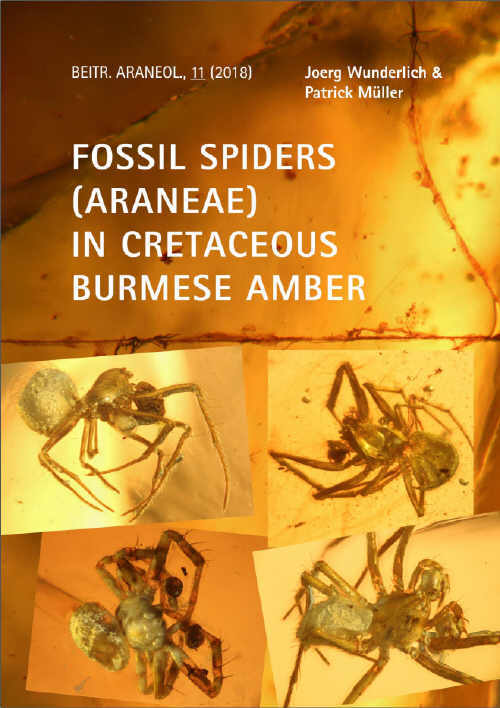
WUNDERLICH, J. (ed.) (2018)
Beitr. Araneol., 11 (2018)
181 pp, ca. 229 drawings and 56 coloured photos.
Download
Beitr._Araneol._Band_11_(2018).pdf
(18 MB)
Beiträge zur Araneologie (Beitr. Araneol.), vol. 12:
What is a Spider? (Araneae)
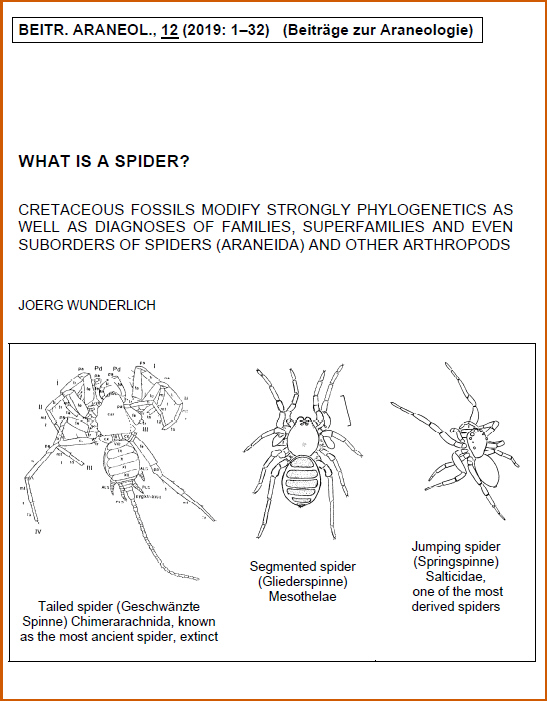
WUNDERLICH, J. (ed.) (2019)
Beitr. Araneol., 12 (2019)
Download
Beitr._Araneol._Band_12_(2019).pdf
(2,2 MB)
Beiträge zur Araneologie (Beitr. Araneol.), vol. 13:
Five Papers on fossil and extant Spiders
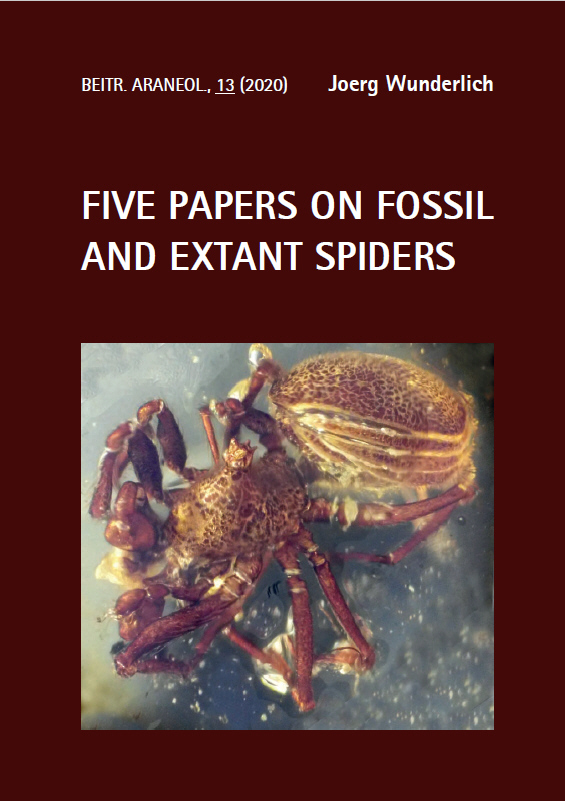
WUNDERLICH, J. (ed.) (2020)
Beitr. Araneol., 13 (2020)
Download
Beitr._Araneol._Band_13_(2020).pdf
(15,6 MB)
Beiträge zur Araneologie (Beitr. Araneol.), vol. 14:
A Paper on Cretaceous Fossil Spiders from Myanmar and a Paper on Extant Spiders
from Portugal (Arachnida: Araneae)
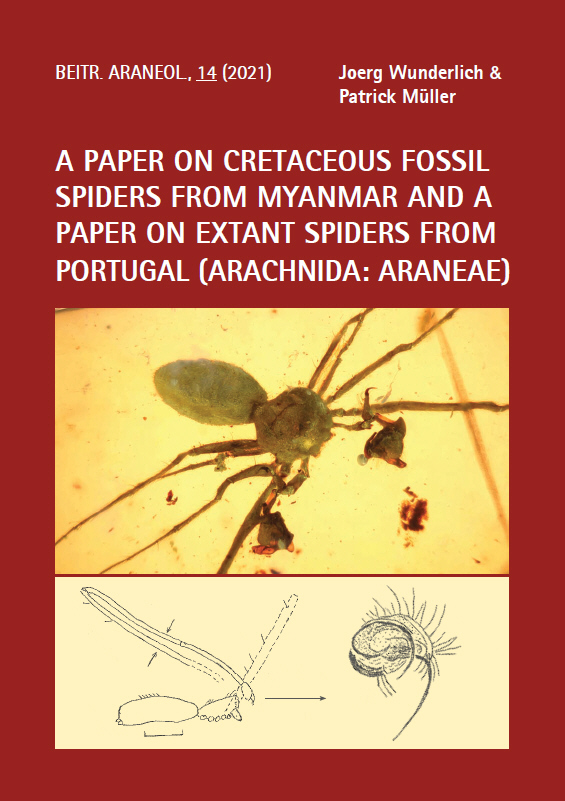
WUNDERLICH, J. (ed.) (2021)
Beitr. Araneol., 14 (2021)
Download
Beitr._Araneol._Band_14_(2021).pdf
(9,0 MB)
Beiträge zur Araneologie (Beitr. Araneol.), vol. 15:
Five Papers on Extant Spiders (Araneida) as well as on Fossil Spiders and Ricinulei
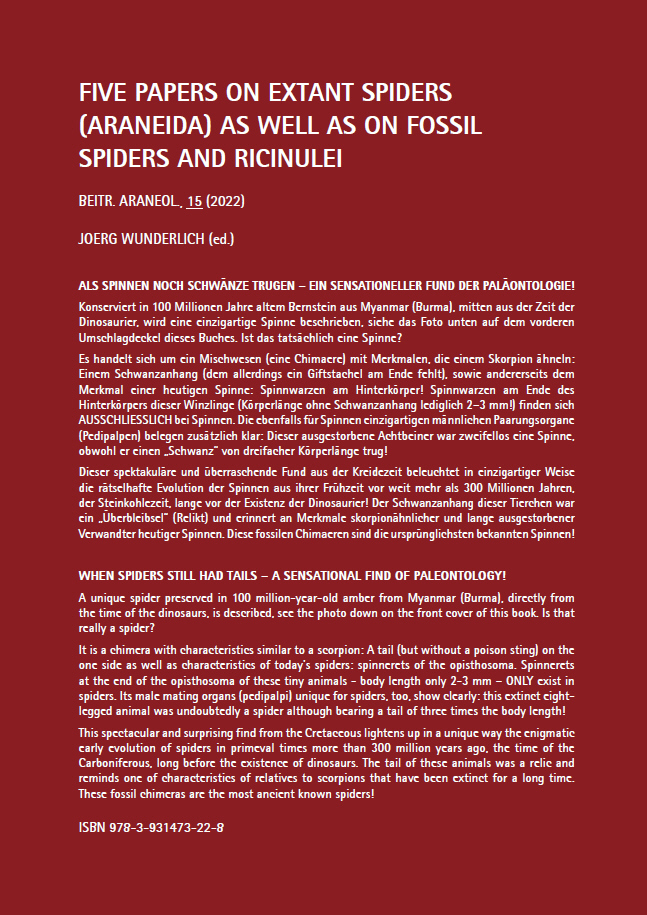
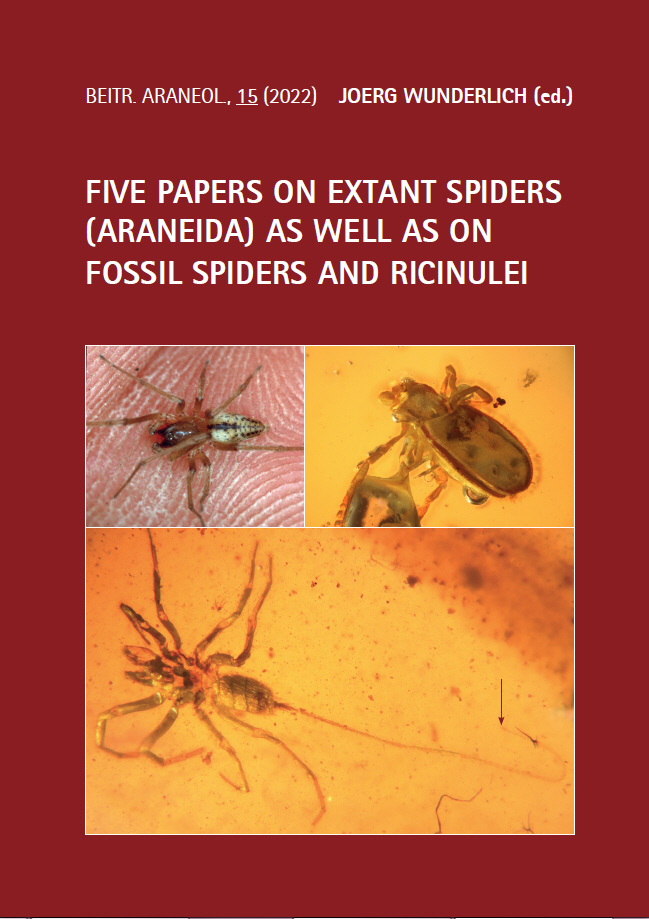
WUNDERLICH, J. (ed.) (2022)
Beitr. Araneol., 15 (2022)
Download
Beitr._Araneol._Band_15_(2022).pdf
(9,0 MB)
Beiträge zur Araneologie (Beitr. Araneol.), vol. 16:
Papers on Extant and Fossil Spiders (Araneida)
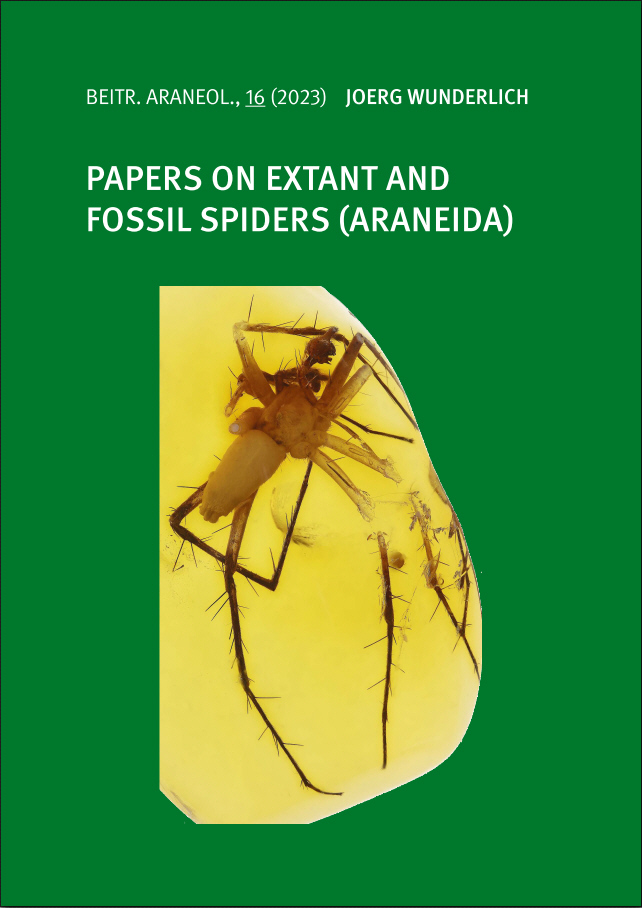
WUNDERLICH, J. (ed.) (2023)
Beitr. Araneol., 16 (2023)
Download
Beitr._Araneol._Band_16_(2023).pdf
(20,7 MB)
Further books by the Publishing House Joerg Wunderlich
BACHOFEN-ECHT, A. (1949) (reprint 1996):
Der Bernstein und seine EinschlĂĽsse
Baltic amber and its inclusions. With an index and notes by J. WUNDERLICH. In German.
225 pages
WUNDERLICH, J. (1986):
Spinnenfauna gestern und heute
Fossil spiders and their living kin.
283 pp, 369 drawings; coloured photos.
In German, with English abstracts.
WUNDERLICH, J. (1987):
Die Spinnen der Kanarischen Inseln und Madeiras
The Spiders of the Canarian Islands and Madeira. Adaptive radiation, biogeography, revisions and descriptions of new species.
437 pp, 717 figs. In German.
Older papers (1969 ff)
See "The World Spider Catalog" by the Natural History Museum Bern.
Orders for the books
Orders (reduced prices for students and pensioners) to:
Publishing House Joerg Wunderlich
Oberer Haeuselbergweg 24
69493 Hirschberg
Germany
Imprint
Jörg Wunderlich
Oberer Häuselbergweg 25
69493 Hirschberg
Germany
Private Laboratory of Arachnology
Mail: joergwunderlich@t-online.de
Datenschutzerklärung
Datenschutz
Jörg Wunderlich als Anbieter dieser Webseite nimmt den Datenschutz im Internet ernst. Die Vorschriften zum Datenschutz werden eingehalten.
Der Nutzung von im Rahmen der Impressumspflicht veröffentlichten Kontaktdaten durch Dritte zur Übersendung von nicht ausdrücklich angeforderter Werbung und Informationsmaterialien wird hiermit ausdrücklich widersprochen. Der Betreiber dieser Seite behält sich ausdrücklich rechtliche Schritte vor im Falle der unverlangten Zusendung von Werbeinformationen, etwa durch Spam-Mails.
Personenbezogene Daten
Die Nutzung von www.joergwunderlich.de ist grundsätzlich ohne Offenlegung Ihrer Identität möglich. Personenbezogene Daten werden nicht erhoben und eine personenbezogene Auswertung findet nicht statt. Eine Weitergabe an Dritte findet nicht statt.
In Verbindung mit Ihrem Zugriff auf www.joergwunderlich.de werden Daten (Logfiles) auf dem von mir genutzten Server gespeichert, die möglicherweise eine Identifizierung zulassen (zum Beispiel IP-Adresse, Datum, Uhrzeit und betrachtete Seiten). Es findet keine personenbezogene Verwertung durch mich statt.
Durch die Auswertung der anonymisierten Daten in den Logfiles bin ich in der Lage, Informationen über die Nutzung der einzelnen Komponenten meiner Webseite zu gewinnen. Dies hilft mir, meine Webseite und deren Nutzerfreundlichkeit stetig zu verbessern. Dieses berechtigte Interesse erlaubt mir, Daten nach Art. 6 Abs. (1) f) DSGVO zu verarbeiten. Durch die Anonymisierung der IP-Adresse wird dem Interesse der Nutzer an deren Schutz personenbezogener Daten hinreichend Rechnung getragen.
Die Daten der Logfiles müssen aus rechtlichen Gründen 90 Tage aufbewahrt bleiben. Alle auf Personen beziehbare Daten werden danach gelöscht.
Weitergabe und Löschung personenbezogener Daten
Alle durch die Nutzung von www.joergwunderlich.de eventuell angefallenen personenbezogenen Daten werden ausschließlich von mir genutzt. Eine Weitergabe an Dritte findet nicht statt.
Einsatz von Cookies
Die Webseite von www.joergwunderlich.de setzt bei der Nutzung keine Cookies. Die volle Funktionalität ist dennoch gegeben.
Links zu anderen Webseiten
www.joergwunderlich.de enthält Links (Verweise) auf andere Websites. Ich weise darauf hin, dass ich keinen Einfluss darauf habe, ob die Betreiber dieser Websites Bestimmungen des Datenschutzes beachten.
Ich erkläre hiermit ausdrücklich, dass zum Zeitpunkt der Linksetzung zu anderen Seiten keine illegalen Inhalte auf den zu verlinkenden Seiten erkennbar waren. Auf die aktuelle und zukünftige Gestaltung, die Inhalte oder die Urheberschaft der gelinkten Seiten habe ich keinerlei Einfluss. Deshalb distanziere ich mich hiermit ausdrücklich von allen Inhalten aller gelinkten Seiten, die nach der Linksetzung verändert wurden.
Ich hafte daher weder für Inhalte oder Gestaltung der verlinkten Seiten, noch für Links, die von diesen auf dritte Seiten verweisen. Die Aufnahme eines Links bedeutet also nicht, dass ich mit allem, was in der zugehörigen Seite steht, einverstanden bin. Jeder soll sich selbst ein Urteil bilden!